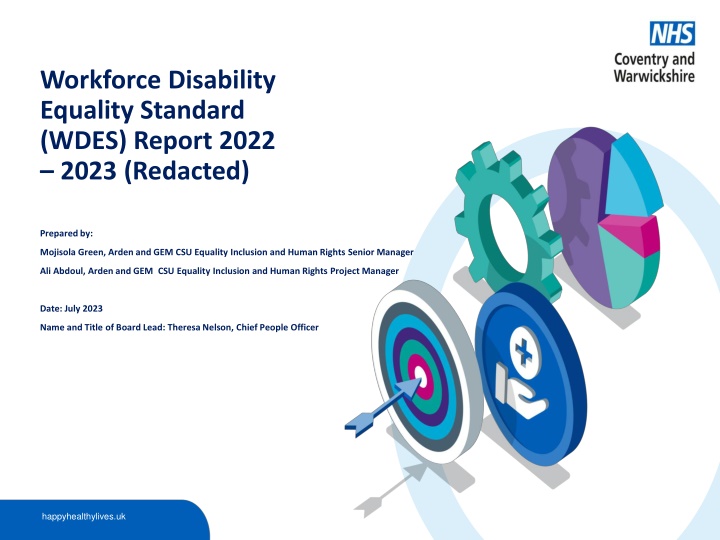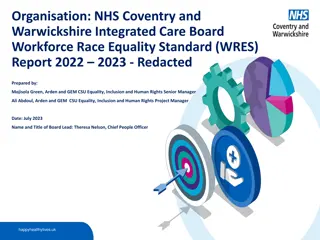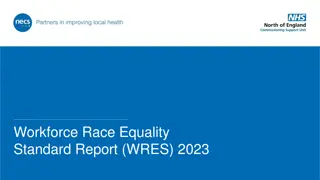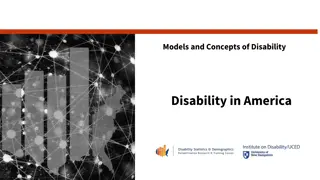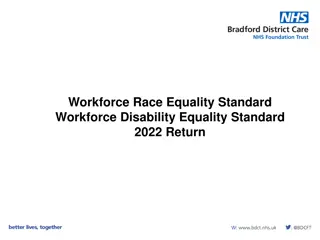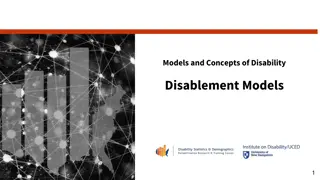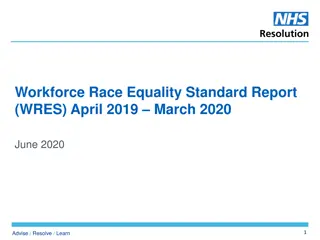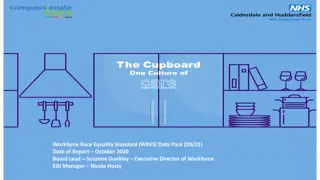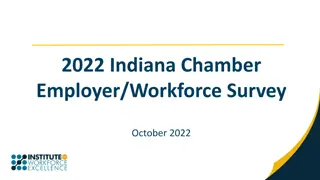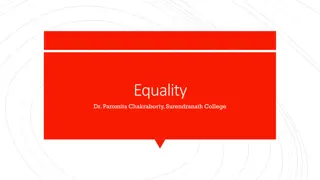Workforce Disability Equality Standard (WDES) Report 2022-2023 Insights
The Workforce Disability Equality Standard (WDES) Report provides a detailed overview of key metrics and findings related to staff experiences and equality measures in NHS organizations. The report delves into specific measures, comparisons, and action plans aimed at promoting disability equality in the workforce. It presents a snapshot of data collected, analyzed, and utilized to drive improvements and demonstrate progress in disability equality practices. This comprehensive report sheds light on the efforts and initiatives undertaken by Coventry and Warwickshire ICB, offering valuable insights for enhancing workplace inclusivity and promoting equal opportunities for all staff members.
Download Presentation

Please find below an Image/Link to download the presentation.
The content on the website is provided AS IS for your information and personal use only. It may not be sold, licensed, or shared on other websites without obtaining consent from the author.If you encounter any issues during the download, it is possible that the publisher has removed the file from their server.
You are allowed to download the files provided on this website for personal or commercial use, subject to the condition that they are used lawfully. All files are the property of their respective owners.
The content on the website is provided AS IS for your information and personal use only. It may not be sold, licensed, or shared on other websites without obtaining consent from the author.
E N D
Presentation Transcript
Workforce Disability Equality Standard (WDES) Report 2022 2023 (Redacted) Prepared by: Mojisola Green, Arden and GEM CSU Equality Inclusion and Human Rights Senior Manager Ali Abdoul, Arden and GEM CSU Equality Inclusion and Human Rights Project Manager Date: July 2023 Name and Title of Board Lead: Theresa Nelson, Chief People Officer happyhealthylives.uk
Contents Introduction WDEs Metrics Summary of WDES NHS People Plan Metrics 1 & 10 Metrics 2 & 3 Metric 4 Metrics 5 to 9 Staff Engagement WDES Action Plan Further Information and Contact Details Page 3 Page 4 Page 5 Page 6 Page 7 Page 9 Page 10 Page 11 Page 12 Page 13 Page 14 happyhealthylives.uk
Introduction The Workforce Disability Equality Standard (WDES) is a set of ten specific measures (metrics) which enables NHS organisations to compare the workplace and career experiences of staff with disability and staff without disability. NHS organisations use the metrics data to develop and publish an action plan with year-on-year comparisons to demonstrate progress against the indicators of disability equality. As part of our continuing improvement approach and commitment to developing good practice the Coventry and Warwickshire ICB voluntarily completed WDES data using the NHSE submission template. The information presented in this report is drawn directly from the Electronic Staff Record (ESR) and from the National Staff Survey database. The data used is a snapshot of 31st March 2023. The report has the following key roles: To enable organisations to compare their performance with others in their region and those providing similar services, aiming to encourage improvement by learning and sharing good practice To provide a national picture of WDES in practice, to colleagues, organisations and the public on the developments in the workforce disability equality agenda Note on redacted data: Where the numbers of staff (or associated identifying data) for a category are below five the detail has been redacted. This is to ensure anonymity and that individual members of staff cannot be easily identified. The numbers less than five are represented in the data by the symbol - . This does not mean that there were zero numbers rather that they are less than five. If there were no counts at all the number zero would be kept in the data. happyhealthylives.uk
The Workforce Disability Equality Standard (WDES) Metrics 1 Percentage of staff with disability in each of the Agenda for Change Bands 1-9 OR Medical and Dental subgroups, and VSM (including executive board members) compared with the percentage of staff in the overall workforce 2 Relative likelihood of staff with disability compared to staff without disability being appointed from shortlisting across all posts. Relative likelihood of staff with disability compared to staff without disability entering the formal capability process 3 4 Percentage of staff with disability compared to staff without disability experiencing harassment, bullying or abuse from patients/service users, their relatives or other members of the public, managers, other colleagues Percentage of staff with disability compared to staff without disability believing that their organisation provides equal opportunities for career progression or promotion. 5 6 Percentage of staff with disability compared to staff without disability saying that they have felt pressure from their manager to come to work, despite not feeling well enough to perform their duties. 7 Percentage of staff with disability compared to staff without disability saying that they are satisfied with the extent to which their organisation values their work. 8 Percentage of staff with disability saying that their employer has made adequate adjustment(s) to enable them to carry out their work. The staff engagement score for staff with disability compared to staff without disability and the overall engagement score for the organisation 10 Percentage difference between the organisation s Board voting membership and its organisation s overall workforce 9 happyhealthylives.uk
Summary of WDES DeclarationRate (data quality) The NHS Coventry and Warwickshire ICB disability declarationrate is 5.23% on ESR. This is an improvement on 2022 at 3.06%. The NHS anonymousStaff Survey declaration rate has also increased from 18.9% to 23.5%. In Coventry and Warwickshire 17.30% of people declared a disability.The gap between staff representationand population representationis -15.84%. Change RAG Rating Metric 2022-2023 Summary 2021-2022 2022-2023 On average 5.4% of non clinical staff have declared a disability This is 1.9% higher than last year at 3.5%. However, there is still no representation at band 8c and above. For clinical staff, on average 5% have declared a disability. This is higher than last year at 2.3%. 1 Under Developed Under Developed Candidates without disability were 0.82 times more likely to be appointed from shortlisting compared to applicants with disability. This is a significant improvement from 7.45 in 2022. 2 Under Developed Achieving No staff with disability entered thecapabilityprocess over the last two years . 3 Developing Achieving 27.1% of colleagues with disability experience bullying, harassment or abuse from patients/service users or the public. This is higher than last year at 25.6%. 20% of colleagues with disability experience bullying, harassment or abuse from managers. This is significantly higher than last year at 7.1%.20.3% of colleagues with disability experience bullying, harassment or abuse from other colleagues. This is significantly higher than last year at 16.3%. 58.3% of colleagues with disability experience bullying, harassment or abuse reported it. This is an improvement from last year at 53.8%. 4 Under Developed Under Developed 46.7% of staff with disability believe the ICB provides equal opportunities for career progression or promotion. This is an improvement on last year at 35.7% but lower than the colleagues without disability at 58.8% and the ICB median at 50%. 5 Under Developed Developing 29.8% of staff with disability feel pressure from their manager to come to work despite not feeling well. This is higher than last year at 21.4% and than colleagueswithout disability at 6.7% and the ICB median at 15.6%. 6 Under Developed Under Developed 44.1% of colleagues with disability feel their work is valued by the ICB, compared to 45.9% for colleagueswithout disability. This is an improvement on last year at 35.7% but lower than colleagues without disability at 45.9%. 7 Under Developed Developing 80.0% of colleagues with disability feel they have sufficient adjustments in place to carry out their duties. This is an improvement on last year at 70% and similar to the ICB median at 80.4%. 8 Under Developed Achieving The staff engagement score for staff with disability is 6.3. This is lower than the score for staff without disability at 7.1 and the ICB median at 7. 9 Under Developed Developing Board Members: With a total number of 12 board members, the representation of people with disability at Board level is currently 8.33%. The percentage difference between the board voting membership and the overall ICB workforce is 3%. 10 Under Developed Developing happyhealthylives.uk
NHS People Promise There is strong evidence that where an NHS workforce is representative of the community that it serves, patient care and the overall patient experience is more personalised and improves . The NHS People Promise sets out the approach to support transformation across the whole NHS. It focuses on how we must all continue to look after each other and foster a culture of inclusion and belonging. " The detail of the People Promise can be found here The WDES is deeply rooted in the fundamental values, pledges and responsibilities set out in the NHS People Promise. happyhealthylives.uk
Metric 1 and 10 Percentage of staff in each of the Agenda for Change (AfC) Bands 1-9 and VSM (including executive Board members) compared with the percentage of staff in the overall workforce including board members Note on redacted data: Where the numbers of staff for a category are below five (or associated identifying data) the detail has been redacted. This is to ensure anonymity and that individual members of staff cannot be easily identified. The numbers less than five are represented in the data by the symbol - . This does not mean that there were zero numbers rather that they are less than five. If there were no counts at all the number zero would be kept in the data. Unknown % Unknown Total Non Clinical Staff With %With Without % Without disability disability disability disability Under developed Total - 5.4% - 80.9% - 13.8% - With % With Without disability % Without disability Unknown % Unknown Total Clinical Staff Under Developed disability disability - 5% Total - 79.3% - 15.7% - With disability % With disability Without disability % Without disability % Unknown Total Board Unknown Developing Total - 8.33 - 75% - 16.66 - happyhealthylives.uk
Metric 1 and 10 Narrative What is the data telling us? As of 31st March 2023, there is significant under representation at all pay bands. On average 5.4% of nonclinical staff have declared a disability. This is 1.9% higher than last year at 3.5%. However, there is still no representation at band 8c and above. For clinical staff, on average 5% have declared a disability. This is higher than last year at 2.3%. However, there is no representation at bands 8b, 8c, 8d and 9. Board Members: The representation of people with disability at Board level is currently 8.33%. The percentage difference between the board voting membership and the overall ICB workforce is 3%. What are we planning Regularly monitor and review Staff with disability workforce demographics and set appropriate/relevant improvement Key PerformanceMeasures (KPI s) Promote the importance of declaring equality information through regular communications and campaigns. Beginning with the application stage and throughout the employee journey. Encourage staff at all levels, and board members to regularly update their equality and diversity information on ESR. Produce an action plan to improve and increase the attraction, recruitment and retention of staff and Board members with a disability and ensure that employees from these backgrounds have equal access to career opportunities and receive fair treatment in the workplace. happyhealthylives.uk
Achieving Achieving Metric 2 Metric 3 Relative likelihood of staff being appointed from shortlisting Relative likelihood of staff entering the formal capability process 0.82 0.00 With disability 11 appointees (10.28%) 0 93 appointees (87%) Without disability What is the data telling us? Metric 2: Candidates without disability were 0.82 times more likely to be appointed from shortlisting compared to applicants with disability. The relative likelihood of non-disabled staff being appointed from shortlisting compared to disabled staff is below 1 in 2023. This is a significant improvement from 7.45 in 2022. Metric 3: No staff with disability entered the capability process over the last two years . What have we done over the last year? Encouraged staff to join ICS/Regional EDI Networks What are we planning Metric 2: Continue to ensure the ICB has robust inclusive, attraction, recruitment and selection practices, and that all the interview panels have gone through robust recruitment and selection training including unconscious bias training. Provide candidate feedback to identify areas of further work. Produce an action plan to improve and increase the attraction, recruitment and retention of staff and Board members with a disability, and ensure that employees from these backgrounds have equal access to career opportunities and receive fair treatment in the workplace. Review and implement a Talent Management Programme derived from e.g. Appraisals / Training Needs Analysis with focus on ensuring fair representation and access Metric 3: Monitor that the formal capability policiesand processes are accessible to staff and ensure they are applied fairly. Encourage and promote the stories/lived experiences of the contributions of all staff from a range of roles experiences and backgrounds acrossthe ICB happyhealthylives.uk
Under Developed Metric 4 Percentage of staff of staff experiencing harassment, bullying or abuse from: With disability Without disability Median Median With disability for ICBs Without disability for ICBs 14.1% 4a) patients / service users, relatives or the public, 27.1% 10.7% 7.3% 4b) managers, 20% 5.8% 15.2% 7.6% 4c) other colleagues, 20.3% 10.4% 15.5% 8.7% 4d) Percentage that reported the incident 58.3% 53.8% 40.9% 42.2% What is the data telling us? For each of the four elements of metric 4, there has been an increase on last year. 27.1% of colleagues with disability experienced bullying, harassment or abuse from patients/service users or the public. This is an increase from 25.6% in 2021. The situation is worsening and almost triple the median for ICBs at 10.7%. 20% of colleagues with disability experienced bullying, harassment or abuse from managers. This is significantly higher than in 2021 at 7.1%. 20.3% of colleagues with disability experience bullying, harassment or abuse from other colleagues. This is an increase from 2021 at 16.3%. 58.3% of colleagues with disability experience bullying, harassment or abuse reported it. This is an improvement from 2021 at 53.8%. What are we planning Consolidate and the strengthen the Freedom to Speak Up Guardian service and promote and encourage it s use by staff. Improve reporting and recording of bullying and harassment cases and outcome and include diversity information within the metrics. Embed Civility and Respect into Equality diversity and Inclusion training /learning opportunities. happyhealthylives.uk
Metrics 5 - 9 Metric 5 Metric 6 Metric 7 Metric 8 Metric 9 Percentage of staff believing that the ICB provides equal opportunities for career progression or promotion. Percentage of staffthat felt pressure from their manager to come to work, despite not feeling well Percentage of staffsaying that they are satisfied with the extent to which their organisation values their work Percentage of staff saying that employer has made adequate adjustments at work With disability With Staff WDES staff survey questions 2022 engagementscore Year With disability Without disability 58.8% With disability 29.8% Without disability 6.7% With disability 44.1% Without disability 45.9% Without disability 7.1 disability 6.3 80.0% 2022 46.7% ICB Median 50.0% 57.6% 15.6% 11.0% 45.6% 52.8% 80.4% 6.6 7.0 What is the data telling us? 46.7% of staff with disability believe the ICB provides equal opportunities for career progression or promotion. This is an improvement on last year at 35.7% but lower than the colleagues without disability at 58.8% and the ICB median at 50%. 29.8% of staff with disability feel pressure from their manager to come to work despite not feeling well. This is 8.4% higher than last year at 21.4% and over 4 times higher than colleagueswithout disability at 6.7% and nearly double the ICB median at 15.6%. 44.1% of colleagues with disability feel their work is valued by the ICB, compared to 45.9% for colleagueswithout disability. This is an improvement on last year at 35.7% but lower than colleagues without disability at 45.9%. 80.0% of colleagues with disability feel they have sufficient adjustments in place to carry out their duties. This is an improvement on last year at 70% and similar to the ICB median at 80.4%. The staff engagement score for staff with disability is 6.3. This is a slight decrease from last year at 6.5 and lower than the score for staff without disability at 7.1 and the ICB median at 7. What are we planning Ensure there is a method to identify BME employees and staff with a disability that are ready to progress to the next step and identify opportunities for them to gain experience at a higher level not forgettingthe overarching importance of equal opportunities. (Stepping up / Ready now) Monitor uptake. happyhealthylives.uk
Metric 9 Under developed Staff Engagement In adopting and implementing the WDES, the NHS Coventry and Warwickshire ICB should engage with staff and the EDI Staff Networks, to ensure that staff with disability feel valued, included and respected for the outstanding contribution they make. Staff with disability involvement is a fundamental part of the whole approach that underpins the WDES. It is important that staff with disability are fully involved in the WDES implementation. For significant improvements to be achieved against the WDES metrics, it is essential that the voices of staff with disability continue to be heard. The EDI Staff Network can provide an important source of knowledge, support and experience, and provide a platform for increasing the visibility of staff with disability. This provide a safe place for staff with disability to share their experiences and be listened to in a compassionate and respected way. What the data is telling us The staff engagement score for staff with disability is 6.3. This is a slight decrease from last year at 6.5 and lower than the score for staff without disability at 7.1 and the ICB median at 7. What have we done over the last year? Wider staff engagement through the newsletter highlighting and signposting information and awareness regarding disability. What are we planning? Programme of training to be developed for all managers on how and when to have regular caring conversations for example in 1-2-1s and appraisals as standard practice. Review of EDI Staff Network membership to ensure that representation is reflective of the ICB s workforce profile and local population in which they work or live, including a clear governance structure to ensure accountability and action is implemented. Have a visible leadership in the forefront that ensure equality, diversity, inclusion and anti-discriminatory behaviours and practices are reflected in corporate governance Encourage and promote the stories/lived experiences of the contributions of all staff from a range of roles experiences and backgrounds across the ICB happyhealthylives.uk
RAG status key Achieving Action Planned for 2023-2024 Developing Underdeveloped Metric Six High Impact action RAG Theme Action Lead Date 1 High Impact Action 2: Embed fair and inclusive recruitment processes and talent management strategies that target under-representation and lack of diversity Regularly monitor and review Staff with disability workforce demographics and set appropriate/relevant improvement Key Performance Measures (KPI s) Promote the importance of declaring equality information through regular communications and campaigns. Beginning with the application stage and throughout the employee journey. Encourage staff at all levels, and board members to regularly update their equality and diversity information on ESR. Review progress quarterly Workforce Data and Quantitative Intelligence Felicity Davies 2 Recruitment, Retention Progression Continue to ensure the ICB has robust inclusive, attraction, recruitment and selection practices, and that all the interview panels have gone through robust recruitment and selection training including unconscious bias training. Provide candidate feedback to identify areas of further work. Produce an action plan to improve and increase the attraction, recruitment and retention of staff and Board members with a disability,, and ensure that employees from these backgrounds have equal access to career opportunities and receive fair treatment in the workplace. Review and implement a Talent Management Programme derived from e.g. Appraisals / Training Needs Analysis with focus on ensuring fair representation and access End March 2024 High Impact Action 2: Embed fair and inclusive recruitment processes and talent management strategies that target under-representation and lack of diversity Felicity Davies 3 Health and Wellbeing Leadership and Culture Monitor that the formal capability policies and processes are accessible to staff and ensure they are applied fairly. Encourage and promote the stories/lived experiences of the contributions of all staff from a range of roles experiences and backgrounds across the ICB Monitor FTSU concerns to identify key areas. Bring ICB values and behaviours to life through personal pledges EDI refresh and awareness training to senior leadership Review Quarterly High Impact Action 6: Create an environment that eliminates the conditions in which bullying, discrimination, harassment and physical violence at work occur. Felicity Davies Health and Wellbeing 4 High Impact Action 6: Create an environment that eliminates the conditions in which bullying, discrimination, harassment and physical violence at work occur. Consolidate and the strengthen the Freedom to Speak Up Guardian service and promote and encourage it s use by staff. Improve reporting and recording of bullying and harassment cases and outcome and include diversity information within the metrics. Embed Civility and Respect into Equality diversity and Inclusion training /learning opportunities. Bring ICB values and behaviours to life through personal pledges Review data from NHS Staff Survey and Datix Review Quarterly Felicity Davies 5 High Impact Action 2: Embed fair and inclusive recruitment processes and talent management strategies that target under-representation and lack of diversity Recruitment, Retention Progression Ensure there is a method to identify BME employees and staff with a disability that are ready to progress to the next step and identify opportunities for them to gain experience at a higher level not forgetting the overarching importance of equal opportunities. (Stepping up / Ready now) Monitor uptake. Felicity Davies Review Quarterly 6 High Impact Action 4: Develop and implement an improvement plan to address health inequalities within the workforce. Leadership and Culture Assess staff uptake of the different occupational health services and wellbeing services Ensure health and wellbeing schemes are regularly promoted and communicated via relevant staff internal communication channels. Felicity Davies 7 , 8, 9, 10 High Impact Action 4: Develop and implement an improvement plan to address health inequalities within the workforce. Leadership and Culture Programme of training to be developed for all managers on how and when to have regular caring conversations for example in 1-2-1s and appraisals as standard practice. Review of EDI Staff Network membership to ensure that representation is reflective of the ICB s workforce profile and local population in which they work or live, including a clear governance structure to ensure accountability and action is implemented. Have a visible leadership in the forefront that ensure equality, diversity, inclusion and anti-discriminatory behaviours and practices are reflected in corporate governance Encourage and promote the stories/lived experiences of the contributions of all staff from a range of roles experiences and backgrounds across the ICB Felicity Davies Review Quarterly happyhealthylives.uk
Further information and contact details To know more If you would like to discuss any element of this report, please contact: Executive Sponsor: Theresa Nelson Or Equality, Inclusion and Human Right Team agcsu.equality@nhs.net happyhealthylives.uk
